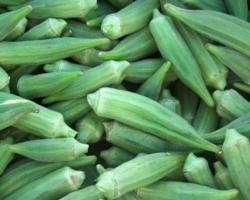Okra
UC Links

Pest management: Search the UC Integrated Pest Management website for specific pests and related plants
The Basics
Okra grows on tall, bushy plants with ornamental leaves and flowers. The red varieties are particularly dramatic in the garden. Both the air temperature and the ground must be warm for heat loving okra to thrive.
When to plant
- Transplant: June–July
- Direct seed: June
- Okra is very sensitive to cold. For best results, wait until daytime temperatures are regularly in the 80s°F and the soil soil temperature over 70°F
- Start in pots for transplants: May–June; ready to transplant in 4 weeks
Harvest window
- Approximately 50–60 days for first pods to mature
- Pods can overmature quickly, so harvest every 2–3 days for tender pods
- Plants will produce through September–October
Care overview
- If starting from seed, soak the seeds overnight or scarify (nick or slightly abrade) the seeds to aid with germination
- Tall varieties may need to be staked
- Remove any overmature pods. Leaving them on the plant will cause it to stop bearing.
More links
- Varieties of Okra You Can Grow [video, 6:47]
- Okra Production in California, UC Cooperative Extension
Recommended Varieties for Santa Clara County
We have no specific varieties to recommended for Santa Clara County. See the UC Davis, Vegetable Research and Information Center okra publication for California-recommended varieties.






